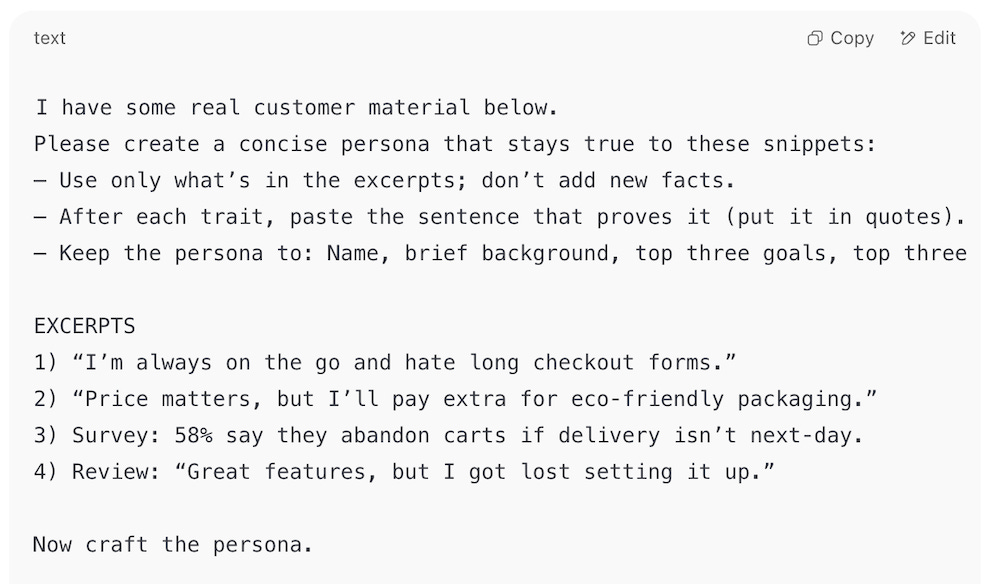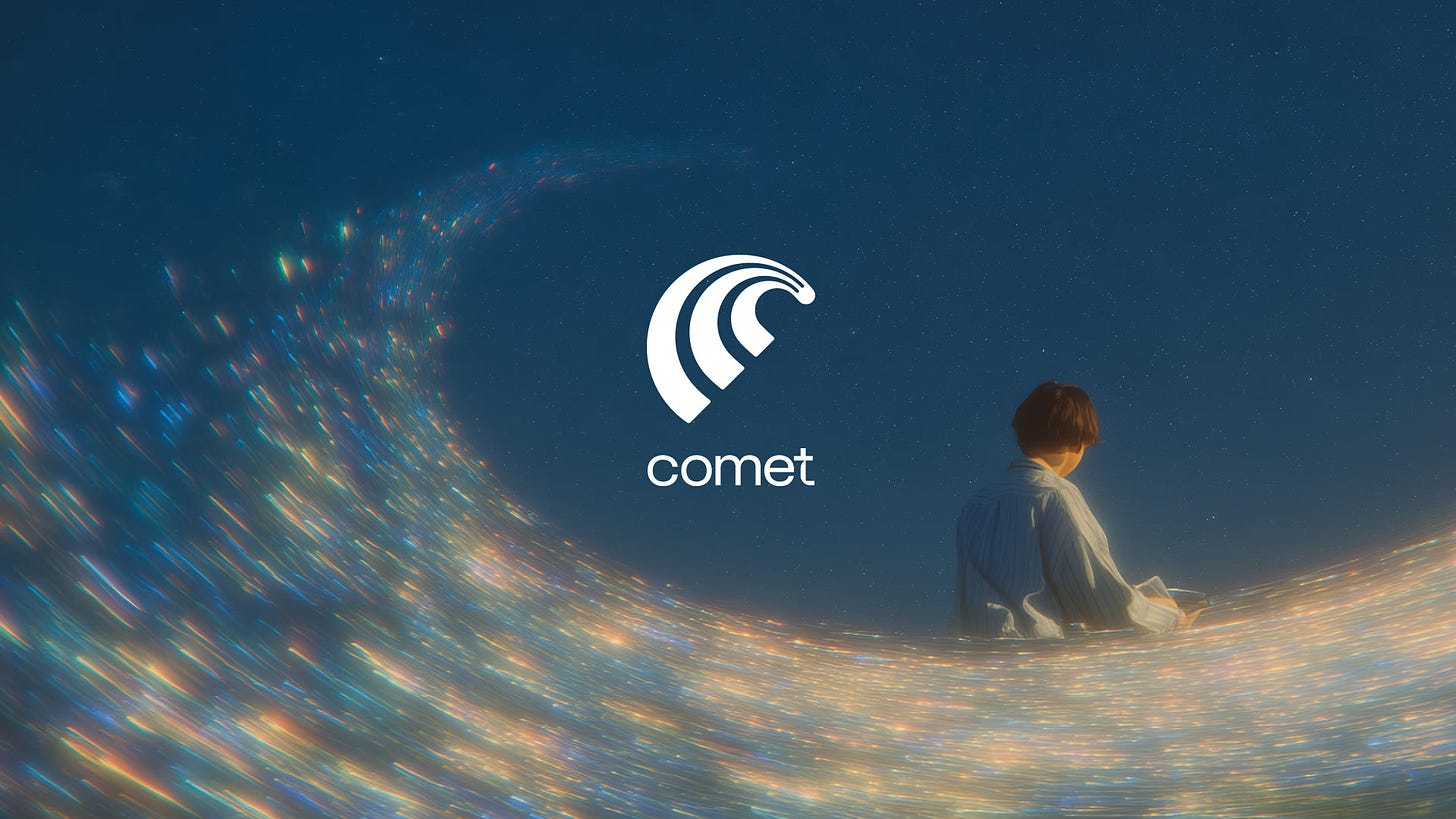Fish Food 652: Using synthetic personas and research to explore ideas
A workflow for using synthetic research, agentic browsers, broken politics, cracking down on AI slop, and writing a letter to your future self
This week’s provocation: How AI synthetic research can inform strategy and innovation
One of the areas of my work which has been truly eye opening recently is the application of synthetic research (using AI generated data and personas to simulate real-world research scenarios) to explore ideas and open up new thinking.
Various pieces of research have shown how accurately AI engines can replicate the responses of human respondents to research. This particularly interesting study from Stanford, for example, replicated the personalities and behaviours of over 1,000 people using AI to conduct two-hour, voice-enabled interviews with the participants. Generative agents were able to replicate participants' responses 85% as accurately as participants replicated their own answers.
But this isn’t a post about how synthetic research can replicate or replace the value of human research. It can’t. Quite apart from anything there’s huge value in the nuances, outliers, edge cases and under-represented viewpoints that can be found through human research. And as Mark Hadfield puts it, AI personas don’t live in the real ‘messy’ world. But it can be very complementary to traditional research and I‘ve found that it can be fantastically useful at exploring concepts, originating new ideas and opening up new possibilities (for more on how to use AI engines as a thought partner see last week’s post).
Synthetic personas may be customers, but they can also be employees, stakeholders, decision-makers, or any audience that may be useful in giving you an insightful perspective on your topic. I’m not a research expert so this is not a definitive guide, and it is focused on qualitative rather than quantitative (which is a whole other ball game). But this reflects how I (and teams I’ve worked with) have used these techniques to explore different ideas and scenarios. So to make this as useful as possible I’ve set out a typical workflow below.
Create a project space
You don’t have to use project spaces in synthetic research of course but the persistent context and memory is fantastically useful (more on using ChatGPT project spaces in strategy here, and you can also use Google Gemini Gems or Claude projects). It also allows you to set up multiple conversational threads which you can use to interview different personas or the same persona about different topics.
Remember to populate the source files with as much contextual information as you can (be careful about uploading sensitive information or data to open GPTs). For example, you can use the 4C’s: Customer (survey feedback, research data, review transcripts, social media reports, verbatim quotes etc); Company (client information, company reports, brand content); Category (sector insights, reports, trends, market maps); Culture (trends reports, cultural research or studies). Then take care to craft the project instructions (e.g. ‘Act as a world class research expert specialising in X, ensure your insights can inform outcome Y, if you don't know the answer say that you are not sure and ask clarifying questions rather than make something up’).
Generate synthetic persona/s
Use as much relevant information as you have within your source material to give context. It can work well to do some human curation first (quotes, reviews, and survey nuggets) to bring some focus to shape how the GPT will construct the persona. You don’t need to necessarily do this but you can drop quotes, reviews, survey verbatims and trend snippets into a spreadsheet, tag these by source or topic, and use that - this helps give more context for the GPT to work from (as visualised below).
After the first pass at a persona you can get it to be more granular by asking about things like tensions, contradictions, decision-triggers, motivations or frustrations, which can help spark better ideas. Another good technique is to stress-test the persona using an out of scope question (like their favourite sport or how they would spend a free Saturday) to validate how accurate it has captured the audience.
Interview the persona/s
Use the GPT to generate simulated answers to your questions. You can get the GPT to suggest suitable questions that will help inform your objective (although be careful about confirmation bias). You can ask the GPT to do a ‘day-in-the-life’ walk through which can help surface hidden contexts, or ask questions like what they would show off about to reveal status drivers, or ask about frustrations with brands and then flip this as a way to reveal what good CX looks like, or ask it to imagine a future scenario where everything works in the way they want and describe what’s changed. You can even do things like ask it about weaknesses that competitors should exploit to steal customers as a way of exposing vulnerabilities.
Another good technique here is to use multi-angle interview loops. For example, use 3 or 4 different interview formats - in-depth interview , laddering (structured questioning technique that repeatedly asks the same question like ‘Why is that important to you?’ to climb from concrete product attributes to underlying personal values and beliefs), future back (where the persona imagines a point in the future and works backward to describe the steps, enablers, and barriers that would get them there). It can also be useful to do parallel interviewing - interviewing the persona tweaking the wording of each question each time, to add in variance, or creativity or different angles. You can then get the GPT to analyse and compare the different transcripts.
Thematic synthesis
You can simply ask the GPT to assimilate the key themes from your synthetic transcripts, and refer it back to the original persona inputs for thematic accuracy checking, but it can also be useful to ask it to list any unusual frustrations or unexpected ideas that showed up only once but which can inspire a fresh concept or feature. This surfaces the quirky, creative insights that often lead to different thinking.
Or you can put the draft theme list back into the GPT and ask it to act as a sceptical colleague to surface anything that might be missing or over-generalised. If you’ve interviewed the persona with multiple versions of similar questions you can ask it to highlight topics that at least three transcripts mention, and give one verbatim line for each. This can help identify themes that feel universal.
New perspectives, ideation and challenging your thinking
There are multiple ways in which synthetic personas can open up new thinking. You can ideate directly from the summarised themes, asking the GPT to use classic ideation techniques such as ‘What if?’ questions and scenarios, or something like SCAMPER (Substitute, Combine, Adapt, Modify, Put to another use, Eliminate, and Reverse). I liked Ethan Mollick’s point about sequencing - coming up with your own ideas before prompting the AI helps avoid AI overly constraining your thinking in the same way that brainstorming individually before coming together as a group leads to a better quality and range of ideas. But you can use the AI to come up with a high quantity of different ideas against your brief, then use it to narrow down based on a set criteria.
A few other techniques which I’ve found useful:
Time-travel diaries
Similar to what I mentioned earlier it can work well to ask each synthetic persona to imagine a typical day five years in the future and narrate it in detail. This can surface hidden frictions, anxieties, or new possibilities.
Persona debates
Put two or three contrasting personas (for example one which is price-driven, one which is ethically-minded) in a group chat and have them argue which of your ideas or early-stage concepts best serves them. The friction can reveal trade-offs and areas which are compromises, sacrifices or must-haves.
Edge-case amplification
Deliberately create extreme or marginal personas (like the ultra-loyal superuser or the tech-skeptical laggard) and interview them as a way to challenge assumptions or generate new ideas. Or dial up a single attribute to the extreme and re-interview the persona to see where that leads.
Reverse-pitch workshops
Invite the persona to play the role of a strategist or innovator like you and ask it to complete your task (e.g. ‘design a product that my company should launch next year that would delight you’).
Cross-industry problem swaps
Clone your core persona, give each clone the mindset of a customer in a very different sector (for example, healthcare or gaming), and ask how they would solve your current challenge.
Use persona divergence to prototype early ideas. Present a rough concept to multiple personas (even if they’re all versions of the same type) and ask each for feedback. The divergence in reactions often helps you identify which idea elements are sticky, surprising, or misaligned—before you ever test with real users. Or present the existing problem statement to a different personas that may bring a different perspective to it, and then ask each persona to rewrite the problem ‘in their own words’ to help reframe it. Then you can generate ‘How might we…?’ questions from the most provocative reframed problems to flip them into solutions and ideas.
All of these approaches can act as a jumping off point for deeper human research, or prototyping and early stage testing. I’ll leave it there but suffice to say that I think synthetic personas are a hugely underrated way of using AI to open up new perspectives, ideas and thinking.
Rewind and catch up:
Have we got personalisation all wrong?
Complexity bias in AI application
Gigantomania and why big projects go wrong
Photo by 3D illustrations on Unsplash
If you do one thing this week…
A potentially significant move this week as Perplexity launch a fully AI-driven browser called Comet, which integrates agentic capabilities right into the browsing experience (you can use it to summarise content, automate workflows like emails, meetings, purchases, and managing tabs via natural‐language commands). It’s starting with a $200/month Max tier invite‑only beta, but is a real sign of things to come. OpenAI are also rumoured to be launching their own browser which will integrate their AI agent Operator enabling the browser to automatically perform tasks for users (think chat interface rather than tabs, bookmarks, URLs). If/when these kinds of browsers gain mass adoption it will fundamentally change the adoption of agentic AI, and will have huge implications for current digital behaviour including browsing, writing, reading, and shopping. It could even signal, as Sean Betts describes it, ‘the end of the internet as we know it’ (and the emergence of Web 4.0).
Links of the week
I don’t normally write about politics on Fish Food but there were some startling stats (based on new polling research conducted by More in Common) at the beginning of this episode of the NewsAgents podcast about how broken people feel that the political system is in the UK, regardless of their political allegiances.
87% of people say they have little or no trust in politicians, 36% say the Covid say that the pandemic was exaggerated by the government to control people, and many feeling that the cost-of-living crisis will never end. It’s clear that trust in the political system, not just politicians or political parties, is at an all time low. Lots to unpack here but the best thing I’ve read on fixing the broken way in which politics works in this country is Iain Dunt’s book ‘How Westminster Works and Why It Doesn’t’. This week I also read a smart post from James Plunkett on seven ways to save bureaucracy from itself which makes a point from systems theory that ‘when a system fails we need to work at the level of the problem’. Worth reading.
Sign of the times? YouTube cracking down on repetitive and ‘mass produced’ AI videos
Google Notebook LM is an excellent research assistant, but it can be hard to find and curate the best source material to inform its thinking. Now they are rolling out a collection of featured notebooks pre-curated by authors and experts which can help you to understand a wide variety of topics.
Ref ‘cognitive debt’ - a good take from Ethan Mollick on how AI can help, or hurt, our thinking. I liked the ‘tutor prompt’ example which can help the AI engine teach you on a topic rather than just give you the answer.
I’m a fan of Sangeet Paul Chowdray’s writing and have pre-ordered his new book: ‘Reshuffle: Who wins when AI restacks the knowledge economy’ (Kindle only in UK for now) which looks excellent.
And finally…
What a lovely idea this is. FutureMe enables you to write a letter to yourself which will be delivered at a specified time in the future. Over 20 million letters have been written over 20 years. (HT Do Lectures)
Weeknotes
This past week has been on the road. I did some teaching with Trinity Business School and a bunch of Brazilian credit cooperative leaders in Stockholm who were a lot of fun. Whilst I was in Stockholm I popped into the Anton Corbijn exhibition which was wonderful.
I then went straight to the Middle East to work with some product leaders on an AI in Product Innovation course, and then delivered a couple of virtual sessions for a ‘Chief AI Officer’ course and did my quarterly trends webinars for Econsultancy. Next week I’m being sent to Coventry (literally, not metaphorically you understand).
Thanks for subscribing to and reading Only Dead Fish. It means a lot. This newsletter is 100% free to read so if you liked this episode please do like, share and pass it on.
If you’d like more from me my blog is over here and my personal site is here, and do get in touch if you’d like me to give a talk to your team or talk about working together.
My favourite quote captures what I try to do every day, and it’s from renowned Creative Director Paul Arden: ‘Do not covet your ideas. Give away all you know, and more will come back to you’.
And remember - only dead fish go with the flow.










Potentially, synthetic persona research can have the depth of qualitative and the scale of quantitative.